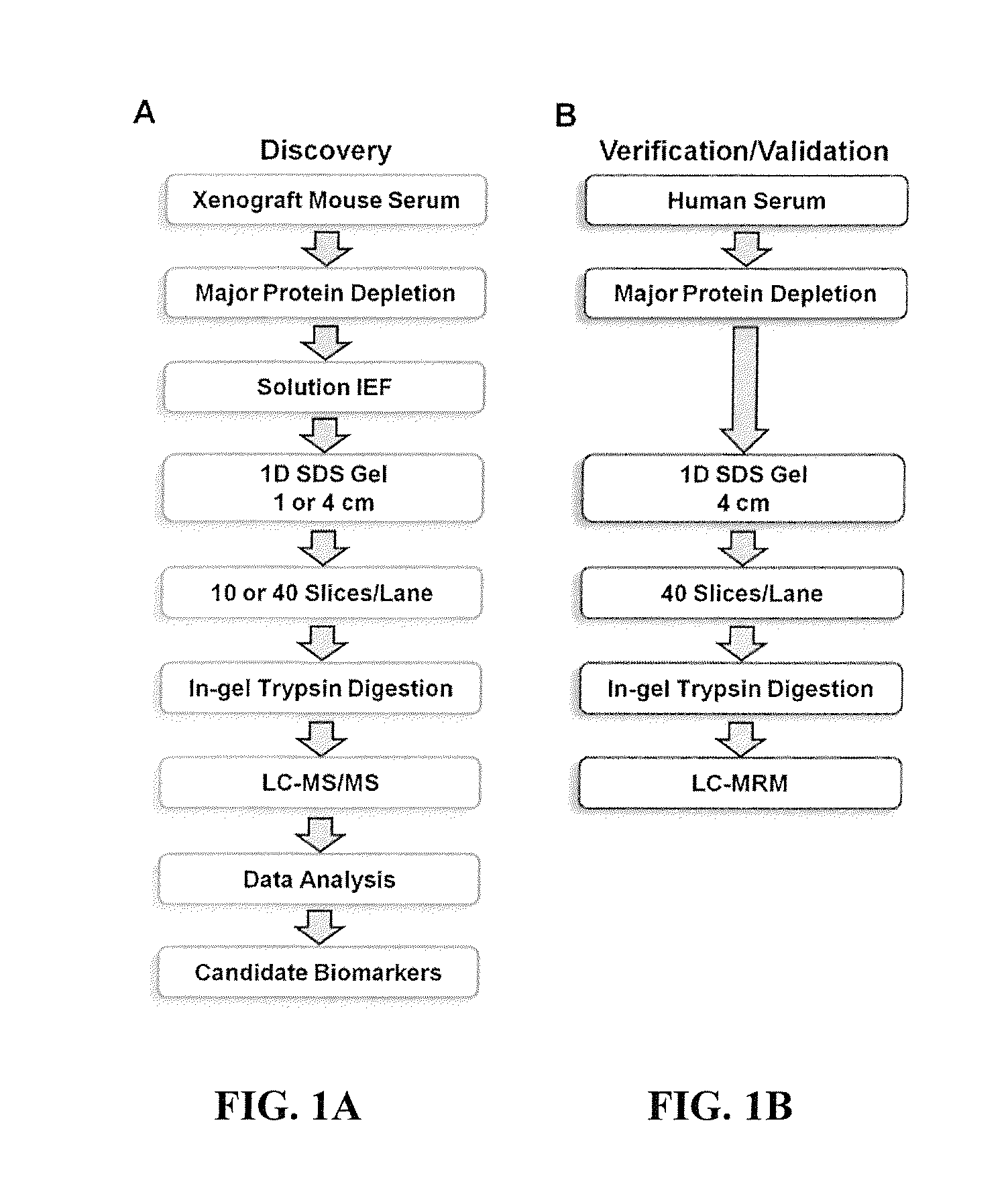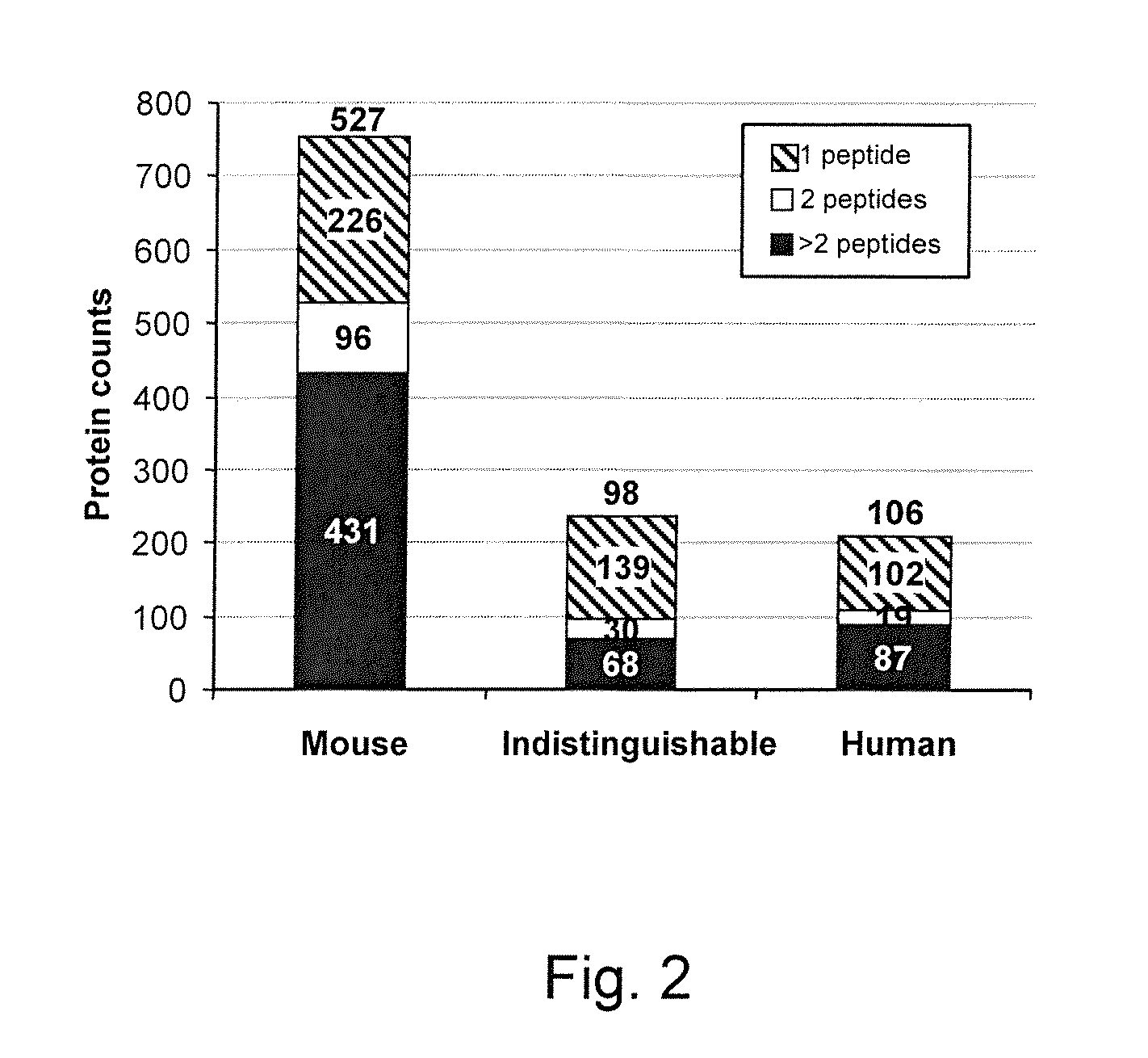Methods and Compositions for Diagnosis of Ovarian Cancer
a technology for ovarian cancer and compositions, applied in the direction of instruments, nucleotide libraries, tumor rejection antigen precursors, etc., can solve the problems of poor protein biomarker for early detection, poor sensitivity and specificity, and ineffective early detection
- Summary
- Abstract
- Description
- Claims
- Application Information
AI Technical Summary
Benefits of technology
Problems solved by technology
Method used
Image
Examples
example 1
Materials and Methods
[0187]Cell Culture.
[0188]The human epithelial ovarian cancer cell line TOV-112D was obtained from the American Type Culture Collection (ATCC, Manassas, Va.). The TOV-112D cells were maintained in a 37° C. incubator with a 5% CO2-95% air atmosphere in a 1:1 mixture of MCDB 105 media and Medium 199 (Sigma-Aldrich, St. Louis, Mo.) supplemented with 15% fetal calf serum, as described previously.40
[0189]Ovarian Cancer Growth In Vivo and Mouse Serum Collection.
[0190]Approximately 3 million TOV-112D cells in 100 μl PBS were injected subcutaneously into the flanks of nine severe combined immunodeficient (SOD) female mice. Tumor volumes were monitored by caliper measurements. When tumors were approximately 1 cm in length, blood was collected from mice by cardiac puncture under anesthesia, animals were immediately euthanized, and the tumor at the injection site and other internal organs were collected.
[0191]The collected blood was allowed to clot at room temperature and ...
example 2
Overview of the Ovarian Cancer Biomarker Discovery and Verification / Validation Strategies
[0213]The general experimental workflow we used for discovery and verification of candidate ovarian cancer protein biomarkers is shown in FIGS. 1A and 1B. For discovery of candidate human biomarkers, serum proteins obtained from SCID mice harboring human ovarian cancer tumors were subjected to a 4-D separation consisting of three sequential, and substantially orthogonal, protein separations, i.e., major protein depletion, solution IEF, and 1-D SDS-PAGE, followed by online, reversed-phase LC peptide separation prior to MS / MS analysis. We previously developed this 4-D protein profiling method for comprehensive analysis of human serum and plasma proteomes, which resulted in the most comprehensive coverage of a serum sample in the pilot phase of the Human Proteome Organization Plasma Proteome Project (HUPO PPP).22, 44 That study also demonstrated that 14 of the 20 proteins known at that time to be i...
example 3
Xenograft Mouse Model of Human Ovarian Endometrioid Cancer
[0215]To identify candidate serum biomarkers using the xenograft mouse model, TOV-112D ovarian endometrioid tumor cells were injected subcutaneously. This cell line was originally derived from a patient with a malignant ovarian tumor that had never been exposed to radiation or chemotherapy.46 This cell line was chosen because it has a fast growth rate and has been demonstrated to form tumors readily in immune-compromised mice. More importantly, the in vitro growth characteristics of the cell line mimic the aggressive clinical behavior of the cancer.46 Previous proteomics biomarker discovery studies used human SKOV-3 serous ovarian cancer cells.36, 38 Certain sets of biomarkers likely characterize different types of ovarian cancer, where some proteins are common to all or multiple cancer subtypes and other proteins are specific to a single subtype.
PUM
| Property | Measurement | Unit |
|---|---|---|
| Ratio | aaaaa | aaaaa |
| Level | aaaaa | aaaaa |
Abstract
Description
Claims
Application Information
 Login to View More
Login to View More - R&D
- Intellectual Property
- Life Sciences
- Materials
- Tech Scout
- Unparalleled Data Quality
- Higher Quality Content
- 60% Fewer Hallucinations
Browse by: Latest US Patents, China's latest patents, Technical Efficacy Thesaurus, Application Domain, Technology Topic, Popular Technical Reports.
© 2025 PatSnap. All rights reserved.Legal|Privacy policy|Modern Slavery Act Transparency Statement|Sitemap|About US| Contact US: help@patsnap.com



